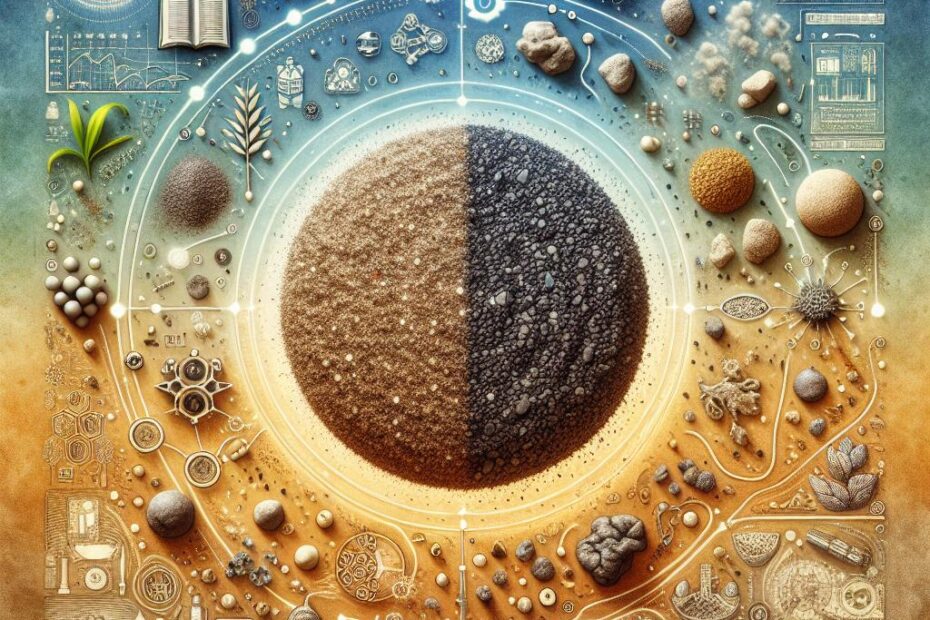Is Soil a Pure Substance or Mixture: Exploring the Complex Nature of Soil
When we think of soil, we often visualize a simple mixture of dirt and rocks. However, the reality is much more complex. Soil is a dynamic, living ecosystem that consists of a combination of organic and inorganic materials. In this article, we will explore the question of whether soil is a pure substance or a mixture and delve into the intricacies of this essential component of our planet.
Understanding the Composition of Soil
To determine whether soil is a pure substance or a mixture, we must first understand its composition. Soil is made up of four main components:
-
Mineral Particles: These are the inorganic materials that make up the majority of soil composition. They include sand, silt, and clay particles that vary in size and texture.
-
Organic Matter: This component consists of decaying plant and animal residues, as well as living organisms such as earthworms, fungi, and bacteria. Organic matter plays a crucial role in soil fertility and health.
-
Water: Soil contains varying amounts of water, which is essential for plant growth and nutrient uptake.
-
Air: Air pockets in soil allow for oxygen exchange, which is necessary for the survival of soil organisms and plant roots.
Is Soil a Pure Substance or Mixture?
So, is soil a pure substance or a mixture? The answer is clear: soil is a mixture. Let’s break down why this is the case:
-
Heterogeneous Nature: Soil is not uniform in composition; it varies in texture, structure, and nutrient content. This heterogeneity is a hallmark of mixtures rather than pure substances.
-
Multiple Components: As mentioned earlier, soil consists of diverse components, including mineral particles, organic matter, water, and air. These components interact with each other to create a complex and dynamic system.
-
Variability: The composition of soil can vary greatly depending on factors such as location, climate, and land use. This variability further supports the classification of soil as a mixture.
-
Chemical Diversity: Soil contains a wide range of chemical elements and compounds, each contributing to its overall complexity. Pure substances, on the other hand, consist of a single type of substance.
The Importance of Soil in Ecosystems
Now that we have established that soil is a mixture, let’s explore its significance in ecosystems:
-
Nutrient Cycling: Soil plays a crucial role in the cycling of nutrients necessary for plant growth. Organic matter decomposition releases nutrients back into the soil, making them available to plants.
-
Water Regulation: Soil acts as a sponge, absorbing and storing water. This helps regulate water flow, reduce erosion, and maintain soil moisture levels for plant growth.
-
Biodiversity Support: Soil is home to a vast array of organisms, from microscopic bacteria to earthworms and insects. This biodiversity is essential for soil health and fertility.
-
Carbon Sequestration: Soil stores a significant amount of carbon, helping mitigate climate change by removing carbon dioxide from the atmosphere.
Practical Tips for Soil Management
Caring for soil is essential for maintaining soil health and productivity. Here are some practical tips for soil management:
-
Soil Testing: Periodically test your soil to assess its pH, nutrient levels, and organic matter content. This information will guide you in making informed decisions about soil amendments and fertilizers.
-
Organic Matter: Incorporate organic matter into your soil through composting, cover cropping, and mulching. Organic matter improves soil structure, fertility, and water retention.
-
Avoid Compaction: Minimize soil compaction by avoiding heavy machinery on wet soil and using mulch to protect the soil surface from erosion.
-
Crop Rotation: Practice crop rotation to prevent nutrient depletion and reduce pest and disease pressure. Different crops have varying nutrient requirements, promoting balanced soil health.
Conclusion
In conclusion, soil is a complex mixture of mineral particles, organic matter, water, and air. Its heterogeneous nature and chemical diversity make it distinct from pure substances. Understanding the composition and importance of soil is essential for sustainable land management and ecosystem health. By caring for our soil through proper management practices, we can ensure its fertility and productivity for future generations. So, next time you dig into the earth, remember that beneath your feet lies a diverse and vibrant world of soil.
Soil is truly a marvel of nature, and recognizing its status as a mixture opens up a world of possibilities for sustainable agriculture, land management, and environmental stewardship. Let’s continue to nurture and protect this precious resource for the benefit of all life on Earth.
